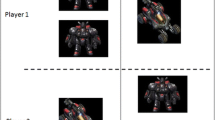Abstract
Identifying groups of player behavior is a crucial step in understanding the player base of a game. In this work, we use a recurrent autoencoder to create representations of players from sequential game data. We then apply two clustering algorithms–k-means and archetypal analysis–to identify groups, or clusters, of player behavior. The main contribution to this work is to determine the efficacy of the Wasserstein loss in the autoencoder, evaluate the loss’s effect on clustering, and provide a methodology that game analysts can apply to their games. We perform a quantitative and qualitative analysis of combinations of models and clustering algorithms and determine that using the Wasserstein loss results in better clustering.
Access this chapter
Tax calculation will be finalised at checkout
Purchases are for personal use only
Similar content being viewed by others
Notes
References
Akiba, T., Sano, S., Yanase, T., Ohta, T., Koyama, M.: Optuna: A next-generation hyperparameter optimization framework. In: Proceedings of the 25rd ACM SIGKDD International Conference on Knowledge Discovery and Data Mining (2019)
Arjovsky, M., Bottou, L.: Towards principle methods for training generative adversarial networks (2017). arXiv:1701.04862
Arjovsky, M., Chintala, S., Bottou, L.: Wasserstein GAN (2017). arXiv:1701.07875
Boubekki, A., Kampffmeyer, M., Brefeld, U., Jenssen, R.: Joint optimization of an autoencoder for clustering and embedding. Machine Learning 110(7), 1901–1937 (2021). https://doi.org/10.1007/s10994-021-06015-5
Calinski, T., Harabasz, J.: A dendrite method for cluster analysis. Commun. Stat.- Theory Methods 3(1), 1–27 (1974). https://doi.org/10.1080/03610927408827101
Cutler, A., Breiman, L.: Archetypal Analysis. Technometrics 36(4), 338–347 (Nov 1994). https://doi.org/10.1080/00401706.1994.10485840
Davies, D.L., Bouldin, D.W.: A Cluster Separation Measure. IEEE Trans. Pattern Anal. Mach. Intell. PAMI-1(2), 224–227 (1979). https://doi.org/10.1109/TPAMI.1979.4766909
Drachen, A., Canossa, A., Yannakakis, G.N.: Player modeling using self-organization in tomb raider: underworld. In: 2009 IEEE Symposium on Computational Intelligence and Games, pp. 1–8. IEEE, Milano, Italy (2009). https://doi.org/10.1109/CIG.2009.5286500
Drachen, A., Sifa, R., Bauckhage, C., Thurau, C.: Guns, swords and data: clustering of player behavior in computer games in the wild. In: 2012 IEEE Conference on Computational Intelligence and Games (CIG), pp. 163–170. IEEE, Granada, Spain (2012). https://doi.org/10.1109/CIG.2012.6374152
Goodfellow, I., et al.: Generative adversarial nets. In: Ghahramani, Z., Welling, M., Cortes, C., Lawrence, N., Weinberger, K.Q. (eds.) Advances in Neural Information Processing Systems, vol. 27. Curran Associates, Inc. (2014), https://proceedings.neurips.cc/paper/2014/file/5ca3e9b122f61f8f06494c97b1afccf3-Paper.pdf
Gulrajani, I., Ahmed, F., Arjovsky, M., Dumoulin, V., Courville, A.: Improved Training of Wasserstein GANs (2017). arXiv:1704.00028
Lloyd, S.: Least squares quantization in PCM. IEEE Trans. Infor. Theory 28(2), 129–137 (1982). https://doi.org/10.1109/TIT.1982.1056489
McInnes, L., Healy, J., Melville, J.: UMAP: Uniform manifold approximation and projection for dimension reduction (2020). arXiv:1802.03426
Paszke, A., et al.: PyTorch: an imperative style, high-performance deep learning library. In: Wallach, H., Larochelle, H., Beygelzimer, A., Alché-Buc, F.d., Fox, E., Garnett, R. (eds.) Advances in Neural Information Processing Systems 32, pp. 8024–8035. Curran Associates, Inc. (2019). http://papers.neurips.cc/paper/9015-pytorch-an-imperative-style-high-performance-deep-learning-library.pdf
Tolstikhin, I., Bousquet, O., Gelly, S., Schoelkopf, B.: Wasserstein Auto-Encoders (2019). arXiv:1711.01558
Author information
Authors and Affiliations
Corresponding author
Editor information
Editors and Affiliations
Rights and permissions
Copyright information
© 2022 IFIP International Federation for Information Processing
About this paper
Cite this paper
Tan, J., Katchabaw, M. (2022). A Reusable Methodology for Player Clustering Using Wasserstein Autoencoders. In: Göbl, B., van der Spek, E., Baalsrud Hauge, J., McCall, R. (eds) Entertainment Computing – ICEC 2022. ICEC 2022. Lecture Notes in Computer Science, vol 13477. Springer, Cham. https://doi.org/10.1007/978-3-031-20212-4_24
Download citation
DOI: https://doi.org/10.1007/978-3-031-20212-4_24
Published:
Publisher Name: Springer, Cham
Print ISBN: 978-3-031-20211-7
Online ISBN: 978-3-031-20212-4
eBook Packages: Computer ScienceComputer Science (R0)





